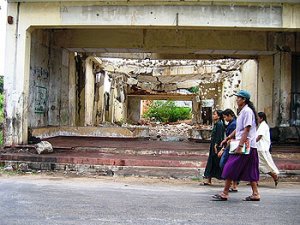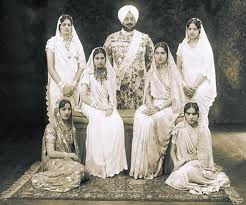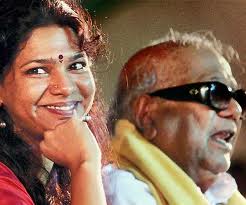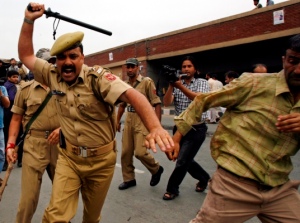 The Sri Lankan Government has a military mindset: it won a war, now it garrisons the peace. Simple as that.
The Sri Lankan Government has a military mindset: it won a war, now it garrisons the peace. Simple as that.
The Sinhalese supremacist narrative told the story of a righteous war: the evil terrorists attacked the righteous Sri Lanka and the brave and peaceful (at the end of the day, aren’t they Buddhist?) Sinhalese were forced to react. 30 years of nightmare were a reaction to the insane plan of a mad leader and his followers. Indeed Prabhakaran was a bloody warrior, he had an obsessive idea and he committed atrocities. But this is only the reverse of what actually happened. The LTTE was a consequence, not the cause.

The ethnic Tamil,working in the plantations, were disenfranchised of the citizenship after independence.
After independence, the Tamils were systematically undermined in the legitimacy of their citizenship: cultural identity, historical heritage were a dangerous claim against the majority. The ideology of a Sinhalese state besieged and threatened in its existence by corrosive forces was the reason of the mandate for president Bandaranaike. The Sinhala Only Act, the decision to downgrade the Tamil culture, was taken on the basis that the simple fact of speaking Tamil is a menace for the entire Sinhalese culture. The Sinhala speaking, Buddhist majority at the time was around 66% of the popultion. The disfranchisement of Plantation Tamil (Tamil of more recent immigration from India: “only” 150 years), put the proportion at 75%. Three quarters of the island is culturally Sinhalese. Nonetheless any presence of difference, is considered a challenge to the majority. The Tamil has been indeed a very influential community. But you can see nowadays the animosity against the Muslim as a product,stemming from the same intolerance.
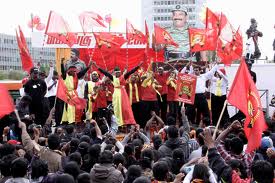 When in the ’70s the pressure to minimize the Tamil identity started to become unbearable, moderate elements of the Tamil society decided that it was a better idea to second the Sinhalese ideology: if you want a state that is completely Sinhalese, then you can have it. We well retreat to our land of origin, the Northern and Eastern Provinces and secede. Of course the Sinhalese extremists consider this an act of rebellion and used an iron fist to put the Tamils in their place. After that, came the LTTE, a violent, brutal and blind force of reaction against a racist repression.
When in the ’70s the pressure to minimize the Tamil identity started to become unbearable, moderate elements of the Tamil society decided that it was a better idea to second the Sinhalese ideology: if you want a state that is completely Sinhalese, then you can have it. We well retreat to our land of origin, the Northern and Eastern Provinces and secede. Of course the Sinhalese extremists consider this an act of rebellion and used an iron fist to put the Tamils in their place. After that, came the LTTE, a violent, brutal and blind force of reaction against a racist repression.
Note that the decision of living separately and seconding the Sinhalese myth has been considered an act of rebellion. You are a good Tamil citizen if you give up language and culture and embrace the Sinhalisation.
 Then it was war, a fight for survival driven crazy by decades of oppression and humiliation. It is ideological to call this conflict a war on terror, a legitimate act of policing against terrorism. It was a civil war, the eruption of ethnic tension provoked by the intransigence of Sinhalese supremacy. The end of the war brought the victory on the Sinhalese side and it is up the victors to write history. Now they can state that any dissent is aligned with the terrorist insurgency. The militarization in the Northern provinces is only the prosecution of the same Sinhalese supremacy: to repress diversity with violence.
Then it was war, a fight for survival driven crazy by decades of oppression and humiliation. It is ideological to call this conflict a war on terror, a legitimate act of policing against terrorism. It was a civil war, the eruption of ethnic tension provoked by the intransigence of Sinhalese supremacy. The end of the war brought the victory on the Sinhalese side and it is up the victors to write history. Now they can state that any dissent is aligned with the terrorist insurgency. The militarization in the Northern provinces is only the prosecution of the same Sinhalese supremacy: to repress diversity with violence.
The LTTE was a natural consequence of such oppression and the actual exercise of power is the same majoritarian force that caused the reaction. The roots of violence haven’t been eliminated with the annihilation of the LTTE. On the contrary they prosper with under the warmongering regime of Rajapaksa. Nobody but Sinhalese people. This is the brutal, effective message, after the Eelam War. No country for Tamils, no country for Muslims. That implies also: no country for free man (see Lasantha Wickrematunge).



